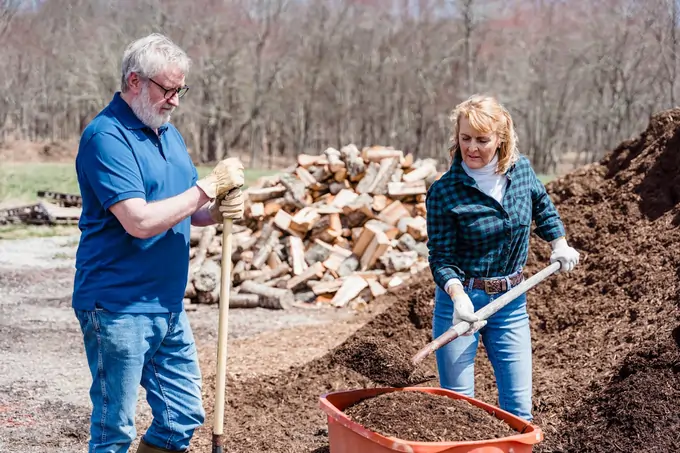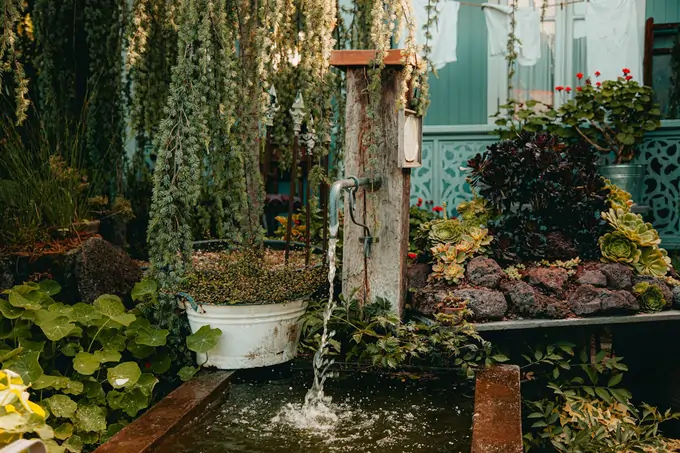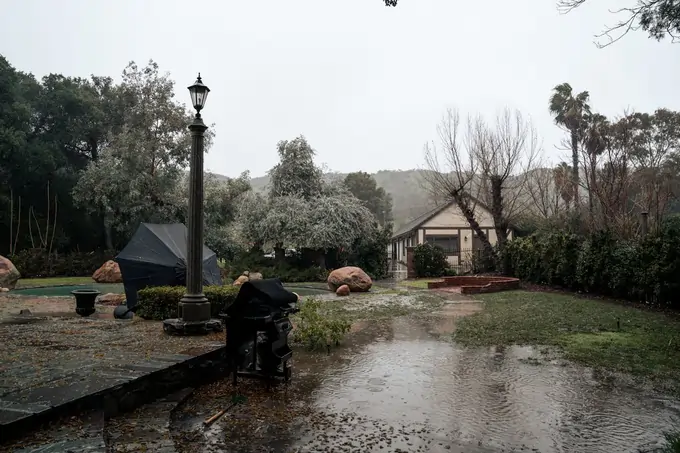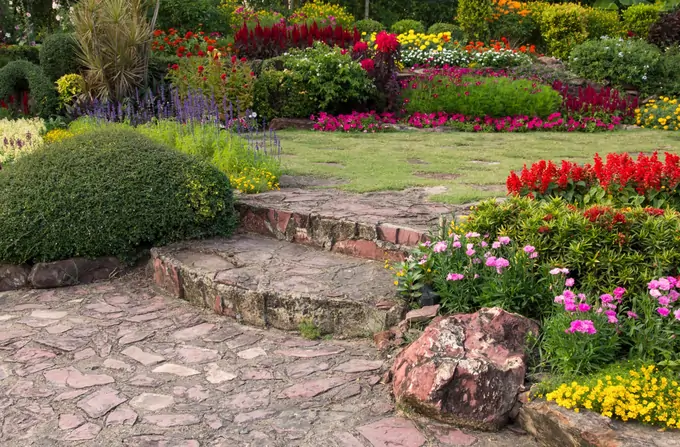Are you tired of spending countless hours mowing, watering, and weeding your front yard? You’re not alone. Many homeowners struggle to keep their landscapes looking pristine while juggling busy schedules and rising water bills. But what if there was a way to create a stunning front yard that requires minimal upkeep?
Enter low maintenance landscaping with rocks and mulch. This smart approach to front yard design with rocks and mulch landscaping ideas can transform your outdoor space into a beautiful, easy-to-maintain oasis. Let’s explore ten innovative ideas that will revolutionize your front yard and free up your weekends.
Low Maintenance Front Yard Landscaping Ideas With Rocks and Mulch
Ever dreamt of a front yard that looks stunning but doesn’t demand constant care? I know the feeling! Imagine a yard that thrives without needing endless watering, mowing, or weeding—this is where rocks and mulch come to the rescue! With these materials, not only do you get a modern, polished look, but you also cut back on maintenance dramatically. Did you know that using rocks can reduce your yard’s water usage by up to 40%? And mulch? It acts like a natural weed barrier and helps retain moisture for plants. Let’s dive into some genius ideas that can help you create a low-maintenance front yard that’s both eco-friendly and stylish.
Benefits of Using Rocks and Mulch in Your Landscape
 Before diving into specific ideas, let’s understand why rocks and mulch are game-changers for low-maintenance landscapes:
Before diving into specific ideas, let’s understand why rocks and mulch are game-changers for low-maintenance landscapes:
- Water conservation: Rocks and mulch minimize water needs by reducing evaporation and retaining moisture in the soil. A study by the University of California found that mulched gardens use 25% less water than unmulched ones.
- Weed control: Mulch acts as a natural weed suppressant, blocking sunlight and preventing weed growth. This can reduce weeding time by up to 80%.
- Durability: Rocks withstand weather better than grass or other plants, maintaining their appearance year-round with minimal intervention.
- Reduced maintenance: Less mowing, watering, and weeding means more time for you to enjoy your outdoor space.
Now, let’s explore how to make these benefits work for your front yard.
Choosing the Right Rocks for Your Front Yard
So, you’re diving into landscape design for a beautiful front yard? Choosing the right rock landscaping can totally transform your space. Whether you’re setting up a flower bed, a walkway, or a water feature, using rocks as an accent adds a cool vibe. Think about pebble paths or large rocks for a bold statement.
With landscape rocks, you can really elevate your garden design. A well-thought-out landscaping project might include a retaining wall or some garden landscaping that adds flair. It’s a smart way to add texture and make your front yard pop. Plus, rocks come in a variety of size and shape, so you can incorporate rocks that fit your home’s front perfectly.
Remember, your front yard’s look boosts your home’s curb appeal and visual appeal. From crushed rock to decorative rocks, landscaping can help add texture and color. Since the front yard is the first thing people see, make it count! Calculate how many rocks you need for less maintenance and a stunning outdoor landscape.
The foundation of any rock-based landscape is, of course, the rocks themselves. But with so many options, how do you choose?
Types of rocks:
- River rocks: Smooth and rounded, perfect for creating a natural, water-worn look.
- Lava rocks: Lightweight and porous, ideal for areas needing good drainage.
- Gravel: Versatile and affordable, great for pathways and large areas.
- Decomposed granite: Finer texture, excellent for creating a more formal look.
Color choices:
Select rock colors that complement your home’s exterior. For example, warm-toned rocks like red or tan can enhance a brick facade, while cool grays or whites might better suit a modern, minimalist home.
Enhancing drainage and preventing erosion:
Strategically placed rocks can direct water flow and prevent soil erosion. A landscape architect in Seattle reported a 60% reduction in erosion issues after implementing rock-based drainage solutions in sloped front yards.
How to Effectively Use Mulch for Low Maintenance Landscaping
 Want a low-maintenance way to add visual interest to your yard? Mulch brings a lot to the table! Combine rocks with mulch for a residential landscape that really sets the tone. Use rock landscaping to highlight landscaping features and create a cohesive overall look and feel.
Want a low-maintenance way to add visual interest to your yard? Mulch brings a lot to the table! Combine rocks with mulch for a residential landscape that really sets the tone. Use rock landscaping to highlight landscaping features and create a cohesive overall look and feel.
When you choose plants and landscaping materials, think about the aesthetic appeal and how rocks and stones can enhance it. Use rocks to create borders or pathways in your front yard with rocks that complement the larger landscape. Your yard will benefit from the water and maintenance savings.
For that extra wow factor, add landscape lighting to your design. Select rocks that complement the plants and materials you’ve chosen. The right rocks to choose will enhance the visual interest to your yard while requiring little maintenance. Natural stone and rocks and stones provide a beautiful, enduring touch.
Mulch is the unsung hero of low maintenance garden ideas. Here’s how to use it effectively:
Organic vs. inorganic mulch:
- Organic mulch (bark, wood chips, straw) decomposes over time, enriching the soil.
- Inorganic mulch (rocks, rubber) lasts longer but doesn’t improve soil quality.
For truly low-maintenance landscaping, a combination of both can be ideal.
How much mulch to use:
Apply a 2-3 inch layer of mulch around plants and in beds. This depth is optimal for moisture retention and weed suppression without suffocating plant roots.
Mulch layering tips:
- Remove existing weeds before applying mulch.
- Use landscape fabric underneath for extra weed protection.
- Keep mulch a few inches away from plant stems and tree trunks to prevent rot.
Rock and Mulch Design Ideas for Small Front Yards
 Looking to jazz up your small front yard with some cool rock and mulch design ideas? You’re in luck! Go for minimal maintenance with a mix of green plants and rocks. This creates a cohesive design that’s easy on the eyes and fits into your yard’s overall design. Happy gardening!
Looking to jazz up your small front yard with some cool rock and mulch design ideas? You’re in luck! Go for minimal maintenance with a mix of green plants and rocks. This creates a cohesive design that’s easy on the eyes and fits into your yard’s overall design. Happy gardening!
Even small spaces can benefit from rock and mulch landscaping. Here are some ideas:
- Create winding pathways using different sizes of gravel or river rocks. This adds visual interest and breaks up the space.
- Incorporate decorative boulders as focal points. One large boulder can make a bigger impact than several small rocks.
- Use mulch as a base for plant beds and borders. This creates a clean, defined look while reducing maintenance needs.
A homeowner in Portland transformed their small 400 sq ft front yard using these techniques, reducing their yard work by 75% and increasing curb appeal by an estimated 15%.
Creating Mulch Islands for Plant Groupings
Mulch islands are a clever way to reduce lawn area while adding visual interest:
- Design curved, organic shapes for a natural look.
- Group plants with similar water needs within each island.
- Use a variety of textures and heights to create depth and interest.
Best plants for mulch islands:
- Ornamental grasses
- Drought-tolerant perennials
- Low-growing shrubs
Combining rocks and mulch in these groupings can create stunning contrasts. Try surrounding larger rocks with finer gravel or using river rocks to create a dry stream bed effect through a mulched area.
Combining Rocks and Mulch with Drought-Resistant Plants
 Xeriscaping with rocks and mulch is an excellent way to create a low-maintenance, water-wise landscape. Here’s why:
Xeriscaping with rocks and mulch is an excellent way to create a low-maintenance, water-wise landscape. Here’s why:
- Drought-tolerant plants thrive in rock and mulch environments, which mimic their natural habitats.
- Rocks and mulch help regulate soil temperature, protecting plant roots from extreme heat or cold.
- The combination reduces water runoff, allowing plants to make the most of limited rainfall.
Top drought-resistant plants for a rock garden look:
- Sedum
- Lavender
- Yucca
- Agave
Arrange rocks and plants in a natural-looking pattern, using larger rocks to create microclimates for more delicate plants. This technique has been shown to increase plant survival rates by up to 40% in hot, dry climates.
Using Mulch to Improve Soil Health
While rocks are permanent, mulch plays a crucial role in ongoing soil health:
- Organic mulch decomposes over time, adding nutrients to the soil.
- Mulch moderates soil temperature, protecting plant roots from extreme heat and cold.
- It helps retain moisture, reducing the need for frequent watering.
To maintain mulch effectiveness:
- Replenish organic mulch annually
- Fluff up compacted mulch with a rake
- Remove any moldy or foul-smelling mulch immediately
A study by the University of Illinois found that mulched beds had 50% more earthworms than unmulched areas, indicating improved soil health.
Rock Gardens: A Perfect Low Maintenance Feature
Rock gardens are the epitome of low maintenance front yard landscaping. Here’s how to create one:
- Choose a sunny location with good drainage.
- Create elevation changes using larger rocks and soil mounds.
- Plant drought-tolerant succulents and alpine plants between rocks.
Low-maintenance plants for rock gardens:
- Hens and Chicks
- Creeping Thyme
- Stonecrop
A rock garden can reduce water usage by up to 60% compared to a traditional lawn of the same size.
How to Edge Mulch and Rock Beds for a Professional Look
Proper edging is crucial for a polished appearance:
- Use sturdy materials like stone, metal, or heavy-duty plastic.
- Install edging before adding mulch or rocks to prevent spillover.
- Create clean, crisp lines for a professional finish.
DIY edging tip: Use a garden hose to lay out curved edges before cutting into the soil.
Budget-Friendly Tips for Landscaping with Rocks and Mulch
Transform your yard without breaking the bank:
- Source rocks locally to save on transportation costs.
- Use a mix of purchased and found rocks for a natural look.
- Make your own mulch from fallen leaves and branches.
DIY vs. Professional Installation:
- DIY can save 40-60% on labor costs
- Professional installation ensures proper drainage and longevity
A homeowner in Austin saved $3,000 by sourcing rocks from a local quarry and installing them himself over a weekend.
By implementing these low maintenance front yard landscaping ideas with rocks and mulch, you can create a beautiful, sustainable landscape that saves time, water, and money. Which idea will you try first? Remember, the key to success is planning and choosing the right combination of rocks, mulch, and plants for your specific climate and style preferences. With a little effort upfront, you’ll enjoy a stunning, low-maintenance front yard for years to come.
Conclusion
With rocks and mulch, creating a low-maintenance front yard is easier than ever! Whether you’re after a modern look with sleek stone pathways or a natural feel with mulch-filled plant beds, these ideas can help you design a landscape that’s beautiful and easy to care for. Remember, the key to success is choosing the right materials and arranging them thoughtfully. So, start small, get creative, and watch your front yard transform into a low-maintenance masterpiece! Ready to give your yard a makeover? Let us know what design ideas you love the most in the comments!



